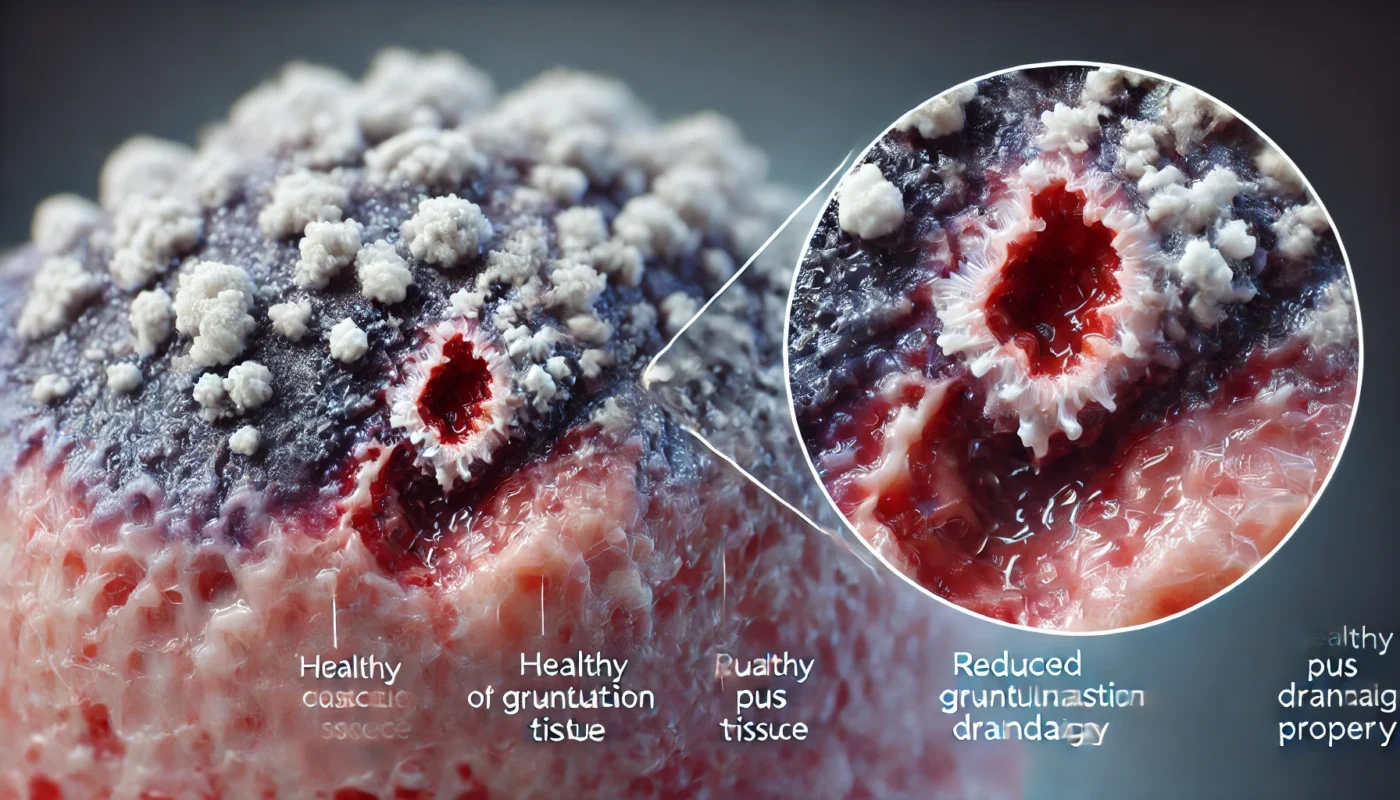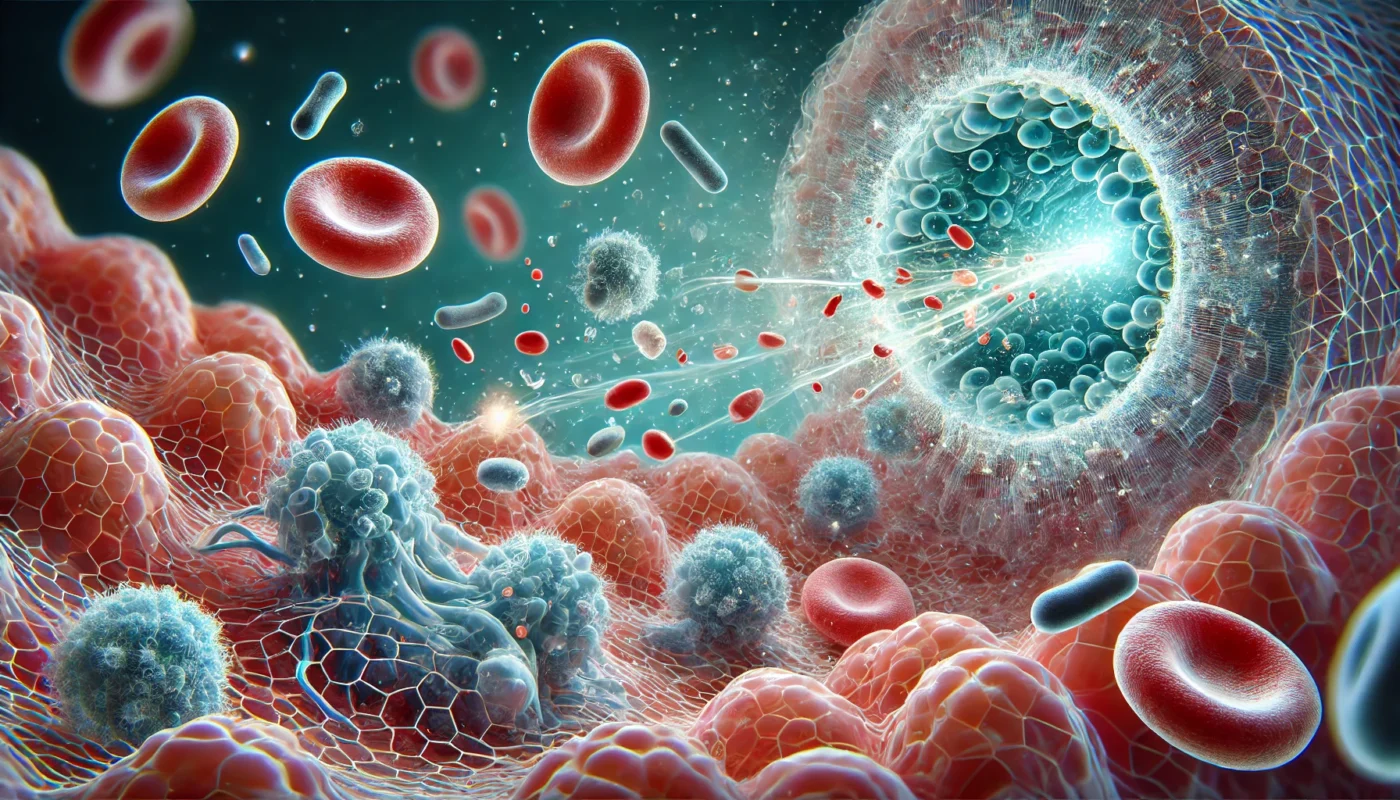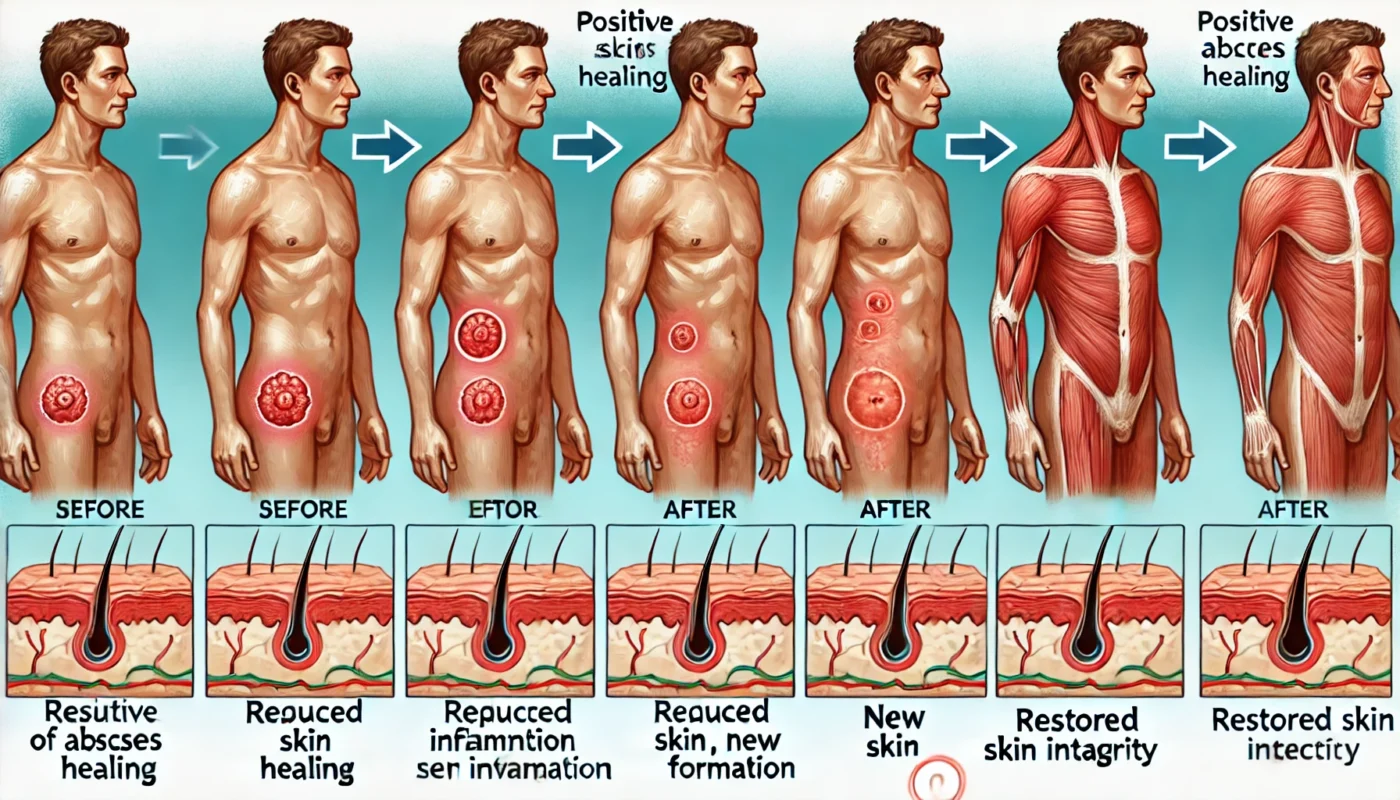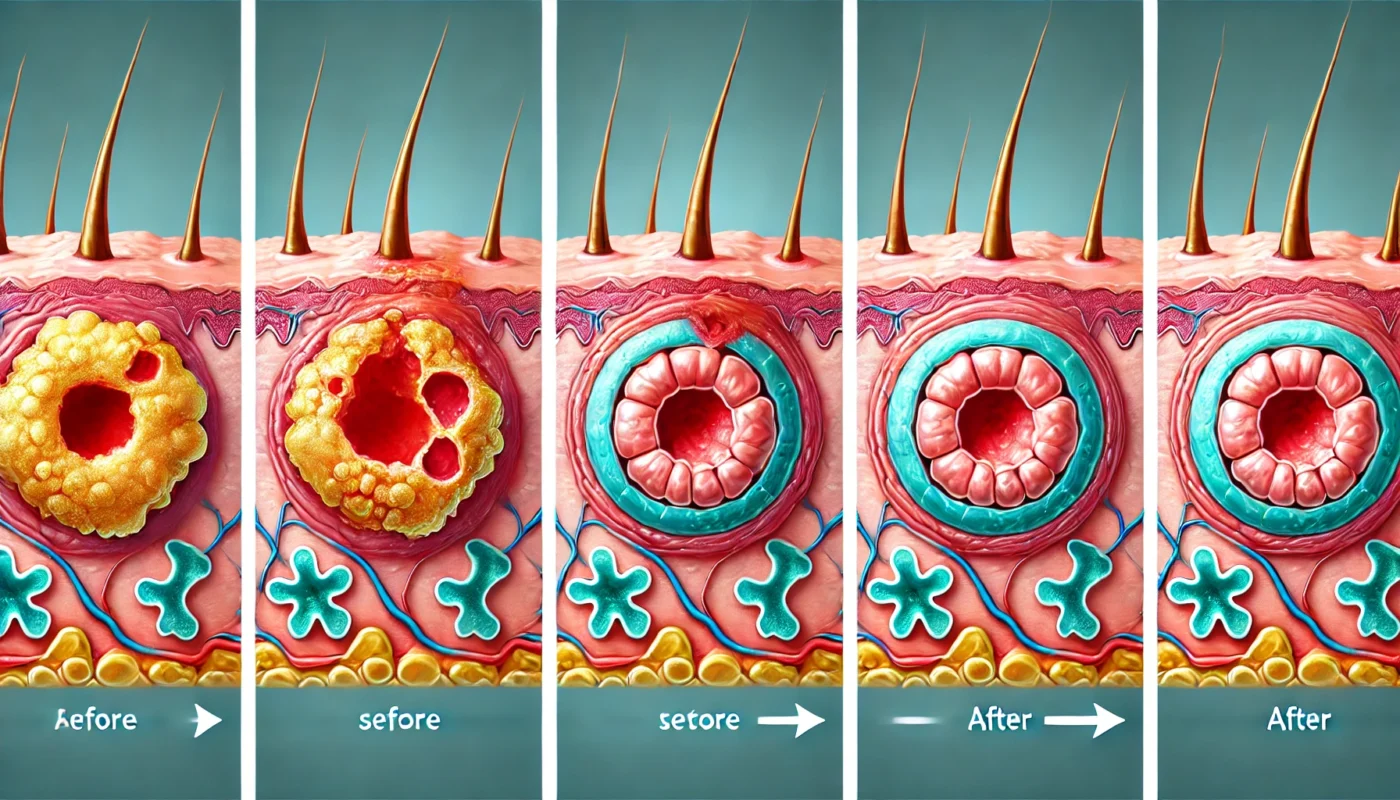An abscess is essentially a pocket of pus that forms due to an infection. The human body’s response to infection involves sending white blood cells to the affected area, leading to inflammation and the accumulation of pus. This natural defense mechanism aims to isolate the infection and prevent it from spreading.
You may also like: Key Factors in Proliferative Wound Healing
The Anatomy of an Abscess
An abscess is not just a simple collection of pus; it is a structured entity with a defined wall. This wall, made of granulation tissue, isolates the infection from the surrounding tissues, preventing the spread of bacteria. Understanding this structure is key to comprehending why some abscesses require surgical intervention while others can resolve with conservative management.
The Role of the Immune System
The immune system’s role in abscess formation and resolution is critical. White blood cells, such as neutrophils, are the first responders, attacking bacteria and forming pus. Over time, macrophages and other immune cells contribute to cleaning up the debris and promoting healing, illustrating the body’s intricate defense strategy against infections.
Types of Abscesses
Abscesses can manifest in various forms, depending on their location and cause. Skin abscesses, dental abscesses, and internal abscesses each have unique characteristics and treatment needs. Skin abscesses are often visible and palpable, while internal abscesses may require imaging for diagnosis. Recognizing these differences helps tailor treatment approaches effectively.
Common Causes of Abscesses
Abscesses can result from a variety of causes, including bacterial infections, foreign objects lodged in the skin, or blocked glands. Common sites for abscess formation include the skin, gums, and internal organs such as the liver or kidneys. Recognizing the underlying cause can inform the treatment approach and expedite healing.
Bacterial Infections
The most common cause of abscesses is bacterial infection, particularly by Staphylococcus aureus. Bacteria can enter the body through cuts, abrasions, or other breaches in the skin. Once inside, they multiply rapidly, triggering the immune response and subsequent abscess formation.
Foreign Objects and Trauma
Foreign objects, such as splinters or thorns, can introduce bacteria into the skin and lead to abscess formation. Traumatic injuries can also create an environment conducive to bacterial growth. Understanding these causes can aid in prevention and early intervention.
Obstructed Glands and Ducts
Abscesses can also arise from blocked sweat glands, sebaceous glands, or ducts, leading to the accumulation of secretions and bacteria. Conditions like hidradenitis suppurativa exemplify this mechanism, where recurrent abscesses occur due to glandular obstruction.

Positive Signs of Abscess Healing
Identifying the signs of healing can provide reassurance and guide your self-care strategies. Here are the key indicators that an abscess is healing:
Reduced Pain and Swelling
A significant reduction in pain and swelling is often the first sign that an abscess is healing. The body’s immune response gradually subsides as the infection resolves, leading to decreased inflammation and discomfort.
Understanding Pain Reduction
Pain reduction occurs as the pressure within the abscess decreases. This happens when the pus drains or is reabsorbed, relieving tension on surrounding tissues. Recognizing this change can be a comforting indication that the body is overcoming the infection.
Mechanisms Behind Swelling Reduction
Swelling diminishes as inflammation subsides. The resolution of inflammation involves the removal of excess fluid and cells from the affected area. The lymphatic system plays a pivotal role in this process, gradually restoring normal tissue architecture.
Psychological Impact of Pain Relief
Pain relief not only signifies physical healing but also has psychological benefits. Reduced pain can alleviate stress and anxiety, improving overall well-being and allowing individuals to engage more actively in daily activities and self-care practices.
Drainage of Pus
While the presence of pus can be alarming, its drainage is a positive sign of healing. As the abscess drains, the body eliminates the infectious material, reducing pressure and promoting recovery. However, it’s crucial to manage the drainage properly to prevent further infection.
Natural Drainage vs. Medical Intervention
Pus drainage can occur naturally or through medical intervention, such as incision and drainage. Both methods aim to clear the infection, but medical intervention may be necessary for larger or more complex abscesses. Understanding when to seek professional help is critical.
Managing Drainage Safely
Proper management of drainage involves keeping the area clean and covered. Using sterile dressings and maintaining hygiene prevents secondary infections. It is important to monitor for any changes in the drainage that may indicate complications.
Psychological Relief from Drainage
Seeing pus drain can provide psychological relief, signaling that the body is actively fighting the infection. This visible sign of progress can boost confidence in the healing process and encourage continued adherence to treatment and care protocols.
Formation of a Scab
The formation of a scab over the abscess site is a classic indication of healing. A scab acts as a protective barrier, shielding the underlying tissue from infection and facilitating tissue regeneration.
The Biology of Scab Formation
Scabs form as blood clots and dries over the wound, creating a natural barrier. This crust protects new tissue from bacteria and debris, allowing the underlying skin to regenerate without interference. Understanding this process underscores the importance of not disturbing the scab.
Importance of Scab Protection
Protecting the scab is essential to avoid reopening the wound and delaying healing. Avoid picking at the scab, as this can introduce bacteria and lead to scarring. Allowing the scab to fall off naturally ensures optimal tissue repair.
Scab Formation and Tissue Regeneration
Beneath the scab, tissue regeneration occurs as cells proliferate and repair the damaged area. Growth factors and proteins orchestrate this complex process, leading to the restoration of normal skin architecture and function.
Improved Skin Condition
As the abscess heals, the surrounding skin typically shows signs of improvement. Redness diminishes, and the skin texture normalizes, indicating that the infection is resolving and the tissue is repairing itself.
Reduction of Redness
Redness decreases as inflammation subsides and blood flow normalizes. This change is often accompanied by a reduction in warmth and tenderness, providing visual confirmation of the healing process.
Restoration of Skin Texture
The restoration of skin texture involves the replacement of damaged cells with new, healthy ones. Collagen production plays a key role in this process, ensuring the skin regains its strength and elasticity.
Psychological Benefits of Skin Improvement
Seeing visible improvement in skin condition can boost morale and confidence. It reinforces the effectiveness of treatment and encourages continued adherence to self-care measures, contributing to overall recovery.
Absence of Fever
Infections often trigger a systemic response, leading to fever. The absence or reduction of fever suggests that the body is overcoming the infection and returning to a state of equilibrium.
Understanding Fever in Infections
Fever is a natural response to infection, signaling the immune system’s activation. It creates an inhospitable environment for pathogens and enhances immune function. Recognizing the resolution of fever is a sign that the immune battle is being won.
Monitoring Fever Trends
Tracking fever trends can provide insights into the infection’s progression. A consistent drop in temperature indicates recovery, while persistent or rising fever may warrant medical evaluation to rule out complications.
Psychological Reassurance from Fever Resolution
The resolution of fever offers psychological reassurance, indicating that the body is successfully combating the infection. This positive sign can reduce anxiety and encourage individuals to remain engaged in their recovery journey.

Supporting Abscess Healing
While recognizing the signs of healing is crucial, actively supporting the process can enhance recovery. Here are some strategies to facilitate abscess healing:
Maintain Proper Hygiene
Keeping the affected area clean is paramount. Gently wash the area with mild soap and water, and apply an antiseptic solution to prevent further infection.
Daily Cleaning Routine
Establishing a daily cleaning routine helps maintain hygiene and prevents infection recurrence. Use clean, warm water and a mild, non-irritating soap to cleanse the area gently. This routine supports the body’s natural healing processes.
Choosing the Right Antiseptic
Selecting an appropriate antiseptic is crucial for preventing secondary infections. Opt for products that are effective yet gentle on the skin, such as iodine or hydrogen peroxide, to disinfect the area without causing irritation.
Importance of Hand Hygiene
Practicing hand hygiene is essential when caring for an abscess. Wash hands thoroughly before and after touching the affected area to prevent the spread of bacteria. This simple step can significantly reduce the risk of additional infections.
Apply Warm Compresses
Applying warm compresses to the abscess can encourage drainage and alleviate discomfort. The heat promotes circulation, which aids in the healing process.
Benefits of Warm Compresses
Warm compresses provide multiple benefits, including pain relief, increased blood flow, and enhanced drainage. The warmth relaxes tissues and dilates blood vessels, facilitating the removal of waste products and supporting healing.
How to Apply a Warm Compress
To apply a warm compress, use a clean cloth soaked in warm water. Ensure the compress is comfortably warm, not hot, to avoid burns. Apply it to the abscess for 10-15 minutes, several times a day, to maximize its therapeutic effects.
Complementary Therapies
In addition to warm compresses, complementary therapies such as gentle massage or elevation of the affected area can enhance circulation and drainage. These techniques, combined with compresses, can speed up recovery and provide additional relief.
Monitor for Complications
While most abscesses resolve with proper care, complications can arise. Monitor for signs of spreading infection, such as increasing redness, swelling, or fever, and seek medical attention if necessary.
Recognizing Warning Signs
Recognizing warning signs early can prevent complications. Look for persistent or worsening symptoms, unusual drainage, or systemic signs like fever or chills. Timely intervention can address issues before they escalate.
Seeking Professional Help
When in doubt, seek professional help. A healthcare provider can assess the situation, recommend appropriate interventions, and provide reassurance. They can also perform necessary procedures, such as drainage, if required.
Preventing Recurrence
Preventing recurrence involves addressing underlying causes and maintaining vigilant care. Follow medical advice, complete prescribed treatments, and continue good hygiene practices to minimize the risk of future abscesses.
Optimize Nutrition
A balanced diet rich in vitamins and minerals supports the immune system and promotes tissue repair. Incorporate nutrient-dense foods, such as leafy greens, lean proteins, and healthy fats, to bolster the body’s natural healing mechanisms.
Key Nutrients for Healing
Certain nutrients play a crucial role in healing. Vitamin C, zinc, and protein are essential for collagen synthesis and immune function. Including these nutrients in the diet supports wound healing and tissue repair.
Dietary Tips for Recovery
Focus on whole, unprocessed foods for optimal nutrition. Incorporate a variety of fruits, vegetables, lean proteins, and healthy fats into meals. Hydration is also vital; drink plenty of water to support cellular functions and overall health.
Supplements and Healing
While a balanced diet is the foundation, supplements can be beneficial if dietary intake is insufficient. Consult a healthcare provider to determine if supplements are necessary, ensuring they complement rather than replace a healthy diet.
Consult a Healthcare Professional
While self-care is important, consulting a healthcare professional can provide additional reassurance and guidance. They can assess the abscess, recommend appropriate treatments, and address any concerns.
When to Seek Medical Advice
Knowing when to seek medical advice is crucial. Persistent pain, fever, or signs of spreading infection warrant professional evaluation. Timely medical intervention can prevent complications and aid recovery.
Role of Healthcare Providers
Healthcare providers play a vital role in managing abscesses. They offer expert assessment, prescribe medications if needed, and perform procedures like drainage. Their guidance ensures safe and effective treatment.
Building a Supportive Relationship
Building a supportive relationship with healthcare providers fosters trust and open communication. Regular follow-ups and clear communication about symptoms and concerns enhance the quality of care and support optimal healing.
The Science Behind Abscess Healing
Understanding the scientific basis of abscess healing can deepen your appreciation of the body’s remarkable resilience. Research indicates that the immune system plays a pivotal role in resolving infections and repairing tissue. White blood cells, such as neutrophils and macrophages, are crucial in eliminating pathogens and facilitating healing.
The Role of Neutrophils and Macrophages
Neutrophils are the first responders, attacking bacteria and forming pus. Macrophages follow, clearing debris and orchestrating healing. These cells release cytokines and growth factors that regulate inflammation and tissue repair, highlighting the immune system’s complexity.
Angiogenesis and Tissue Repair
The body’s ability to form new tissue and blood vessels, known as angiogenesis, is integral to recovery. This complex process is orchestrated by growth factors and signaling molecules that guide cellular responses. Understanding angiogenesis underscores the interconnected nature of healing processes.
The Balance of Inflammation
Inflammation is a double-edged sword in abscess healing. While necessary for fighting infection, excessive inflammation can impede recovery. The body regulates this balance through feedback mechanisms, ensuring inflammation resolves once the infection is controlled.

Conclusion
Recognizing the positive signs of abscess healing is empowering and can alleviate anxiety. By understanding the indicators of recovery and adopting supportive strategies, you can enhance your healing journey. Remember, while abscesses can be uncomfortable, they are often manageable with proper care and attention. Should you have any concerns, consulting a healthcare professional can provide additional support and guidance.
Embracing a Holistic Approach
In summary, the journey to recovery involves not only recognizing the signs of healing but also actively participating in the process through informed self-care and professional consultation. By embracing a holistic approach, you can foster optimal healing and well-being.
The Importance of Patience and Persistence
Healing is a gradual process that requires patience and persistence. Celebrate small victories and remain committed to your recovery plan. With time and care, your body can overcome abscesses and restore health.
Encouragement for the Healing Journey
Stay encouraged on your healing journey. Abscesses may be challenging, but with the right knowledge and support, you can navigate the path to recovery successfully. Trust in your body’s resilience and the power of informed care.
Further Reading:
When Does an Abscess Require Surgery?
How to Drain an Abscess at Home Safely
abscess, healing, warm compress, complementary therapies, infection, nutrition, immune system, healthcare, self-care, recovery, inflammation, angiogenesis, patient education, holistic approach, wound care
Important Note: The information contained in this article is for general informational purposes only, and should not be construed as health or medical advice, nor is it intended to diagnose, prevent, treat, or cure any disease or health condition. Before embarking on any diet, fitness regimen, or program of nutritional supplementation, it is advisable to consult your healthcare professional in order to determine its safety and probable efficacy in terms of your individual state of health.
Regarding Nutritional Supplements Or Other Non-Prescription Health Products: If any nutritional supplements or other non-prescription health products are mentioned in the foregoing article, any claims or statements made about them have not been evaluated by the U.S. Food and Drug Administration, and such nutritional supplements or other health products are not intended to diagnose, treat, cure, or prevent any disease.

